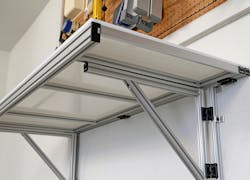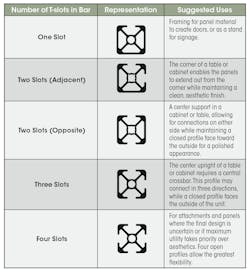T-Slot Aluminum Extrusion: Versatile Solutions for Modern Applications
A popular toy throughout the 20th Century, Erector Sets consisted of metal bars with regularly spaced holes allowing connections with nuts and bolts. Did you ever wonder what would happen if someone made a similarly adaptable system on an industrial scale? Welcome to the wide world of T-slot extrusion, a modular framing system consisting of aluminum profiles with T-shaped slots in one or more sides of the bar.
The slots allow easy assembly of structures using nuts and bolts. Sometimes marketed as an “Industrial Erector Set,” it is well suited to applications like automation, medicine and laboratories due to its adaptability, durability and ease of use. Profiles come in various sizes and configurations, catering to different load-bearing requirements and aesthetic preferences.
Measurement Profiles
There are two primary measurement systems of T-slot extrusion: imperial and metric. Imperial profiles are typically used in North American markets, while international markets or science-centered companies usually choose metric profiles for their structures. Because matching lines of hardware are available for each system, it is important to know which style will be preferred or is already in use.
READ MORE: Automation Streamlines the Window-Making Process
While some hardware is interchangeable between imperial and metric, not all are compatible. The nuts and bolts for 1-in. and 25-mm bars will typically work for the T-slot size. However, the difference is enough that external fasteners like brackets, gussets and mounting plates will not precisely match the width when moving between metric and imperial. This can lead to an unsightly finished product where something looks slightly “off” or is hazardous. For example, if a joining plate designed for a 40-mm bar were used to connect two 1.5-in. bars, the resulting protrusion over the edges would create an opportunity for something to snag on it.
The number and orientation of T-slots on the extruded bars vary depending on the profile’s design. Profiles may feature one, two, three or four slots, strategically placed along the length of the bar with applications suited to each:
Finishes and Weights
Certain manufacturers offer extrusion that is either smooth or produced with grooves in the exterior faces. The advantage of grooved profiles is that they can be aligned during assembly to ensure the bars match properly (Figure 1). Smooth extrusion profiles are particularly suitable for industries like biotechnology, where cleanliness is paramount. Some manufacturers may not offer these finishes for metric and imperial sizing options.
Aluminum is naturally corrosion-resistant, allowing it to be placed in environments where iron or steel would succumb to rust or contamination. Combined with appropriate panel materials and HEPA filtration, aluminum extrusion can even be used to create clean rooms.
There are also many different weights of T-slot extrusion for various applications. For large, load-bearing structures, bigger frames (e.g., 1.5 in. or 40 mm) in the manufacturer’s standard weight are ideal. They offer the best strength and stability for building a raised stage or a laboratory table to support heavy equipment and remain stable. When social distancing protocols were in place, frames of either ultra-lightweight extrusion or the smaller 1-in. or 25-mm models were popular to hold up plastic paneling.
Specialty and Safety Applications
In the ever-growing automation industry, T-slot extrusion provides a stable base for robotic arms and other automation equipment, enhancing precision and efficiency. Profiles can also accommodate mounts for accessory equipment such as monitors, keyboard trays and control panels (Figure 2). This enables the creation of ergonomic workstations where operators can monitor and control automated processes efficiently, and adding casters can create rolling carts with equipment for hospitals and clinics.
READ MORE: Composites Improve Machine Tool Structures
Some advanced profiles include a central channel capable of delivering pressurized gases. While the central cavity of the extrusion cannot typically handle ultra-high pressure, this feature is favorable for applications that need pneumatic capabilities, including laboratory installations.
T-slot aluminum extrusion is also widely used to construct safety guarding for automation systems. Profiles can support the installation of polycarbonate or mesh panels, providing protective barriers around automated machinery. These panels safeguard workers from pinch points, moving parts and flying debris.
Some guarding will protect from active injury, such as in a conveyor system, where nip points are at roller convergence, or a belt terminates at the end of a path. These can be guarded by solid material at the conveyor’s edge to keep body parts from entering dangerous areas.
Other guarding is relatively passive but still important. Plastic and mesh panels protect workers from sparks and shrapnel from cutting, lathing and welding. T-slots can accommodate panels for applications where the clarity of acrylic is required, or polycarbonate’s oil and acid resistance is needed. Because T-slot width varies between different extrusion sizes and manufacturers, a thinner panel can be used where a lightweight application is necessary.
READ MORE: Basics of Aerospace Materials: Aluminum and Composites
However, if impact resistance is a concern, a larger bar with a wider T-slot can accommodate a thicker panel where the strength is needed. For mesh panels inserted into T-slots, a gasket material is commonly used to secure the panel material in the channel.
Enclosing hazardous areas with sturdy frames and transparent panels helps industries adhere to safety regulations without compromising operational visibility. Amputations are debilitating workplace injuries and ensuring proper guarding minimizes the risk of an employee experiencing such a tragic event. Employee safety comes first and protecting these valuable workers is crucial.
A Versatile and Reliable Solution
T-slot aluminum extrusion offers a versatile and reliable solution for constructing frameworks in diverse industrial applications. Its modular design, corrosion resistance and adaptability to various environments (Figure 3) make it indispensable in manufacturing and biotechnology sectors. By leveraging T-slot extrusion systems, industries can enhance productivity, ensure workplace safety and streamline automation processes effectively.
Explore how T-slot aluminum extrusion can transform your industry's framework needs. Whether you are designing automation systems, conveyor assemblies or safety guarding, the versatility and robustness of T-slot profiles provide endless possibilities for innovation and efficiency. Engage your inside team or a qualified third party to start embracing the future of modular framing with T-slot aluminum extrusion.
About the Author

Erin Reilly
Buyer, Motion Automation Intelligence
Erin Dahlvig Reilly is a buyer at Motion Automation Intelligence, focusing on providing automation solutions to facilities across many industries. Since 2018, Reilly has quoted and ordered industrial aluminum framing for safety, manufacturing and recreational applications. She also manages safety for her branch.




